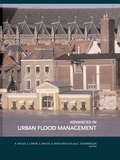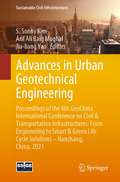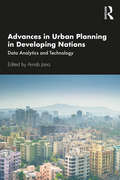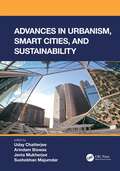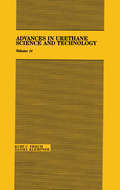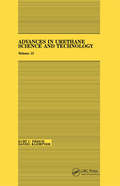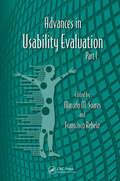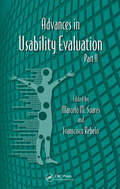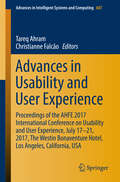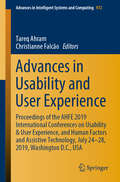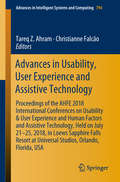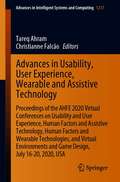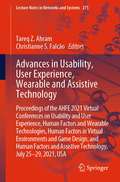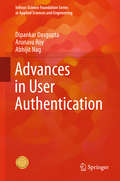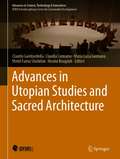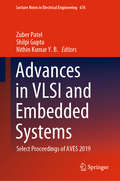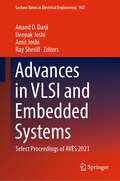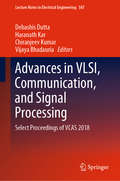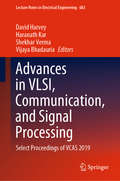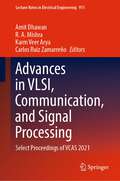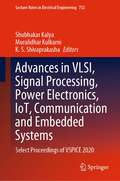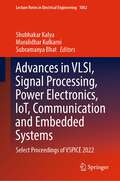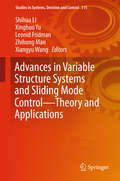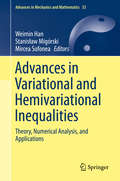- Table View
- List View
Advances in Urban Flood Management
by R. Ashley S. Garvin E. Pasche A. Vassilopoulos C. ZevenbergenOne of the effects of global climate change is the increasing variability of extreme flood events and cyclones. Current measures to mitigate flood impacts, particularly in the urban environment, are based on previously-planned flood risk intervals and no longer provide sufficient protection. Being prepared for unexpected changes and extreme fl
Advances in Urban Geotechnical Engineering: Proceedings of the 6th GeoChina International Conference on Civil & Transportation Infrastructures: From Engineering to Smart & Green Life Cycle Solutions -- Nanchang, China, 2021 (Sustainable Civil Infrastructures)
by S. Sonny Kim Arif Ali Baig Moghal Jia-Liang YaoThis volume discusses a compilation of studies regarding transportation geotechnics, geomechanics, rock mechanics, and geosynthetics reinforced soils from the 6th GeoChina International Conference held in NanChang, China, July 19-21, 2021.
Advances in Urban Planning in Developing Nations: Data Analytics and Technology
by Arnab JanaThis book studies the increasing use of data analytics and technology in urban planning and development in developing nations. It examines the application of urban science and engineering in different sectors of urban planning and looks at the challenges involved in planning 21st-century cities, especially in India. The volume analyzes various key themes such as auditory/visual sensing, network analysis and spatial planning, and decision-making and management in the planning process. It also studies the application of big data, geographic information systems, and information and communications technology in urban planning. Finally, it provides data-driven approaches toward holistic and optimal urban solutions for challenges in transportation planning, housing, and conservation of vulnerable urban zones like coastal areas and open spaces. Well supplemented with rigorous case studies, the book will be of interest to scholars and researchers of architecture, architectural and urban planning, and urban analytics. It will also be useful for professionals involved in smart city planning, planning authorities, urban scientists, and municipal and local bodies.
Advances in Urbanism, Smart Cities, and Sustainability
by Uday ChatterjeeWhile technology is developing at a fast pace, urban planners and cities are still behind in finding effective ways to use technology to address citizen’s needs. Multiple aspects of sustainable urbanism are brought together in this book, along with advanced technologies and their connections to urban planning and management. It integrates urban studies, smart cities, AI, IoT, remote sensing, and GIS. Highlights include land use planning, spatial planning, and ecosystem-based information to improve economic opportunities. Urban planners and engineers will understand the use of AI in disaster management and the use of GIS in finding suitable landfill sites for sustainable waste management. Features Explains the process of urban heritage conservation, including the process of urban renewal and its regeneration and the role of citizens in urban renewal, planning, and management. Includes several case studies highlighting urban environmental problems and challenges in developed and developing countries and the ways for converting urban areas into smart cities. Focuses on urban resources, the supply of energy in smart cities, and their proper management practices. Introduces the role of remote sensing, GIS, and IoT in making a smart city and meeting sustainable goals. Analyzes unique case studies, their challenges and obstacles, and proposes a set of factors to understanding smart city initiatives and projects.
Advances in Urethane: Science & Technology, Volume XIV
by Kurt C. Frisch Daniel KlempnerFlexible polyurenthane foams of all types are a unique group of plastics materials, characterized by the fact that a multitude of different sets of properties can be obtained by varying the levels of a relatively small number of base components in the formulations. Different foam grades, primarily characterized by density and hardness, can be obtained by changing the ratio between base polyol, polymer polyol, water, blowing agent, isocyanate and other components. It is not uncommon for foam producers in industrialized countries to manufacture more than one hundred different foam grades based on these basic chemicals, plus the ancillary chemicals needed for optimized processing. This has always made flexible polyurethane foams a highly suitable candidate for correlating these variations in the formulations with the resulting properties in a mathematical way, aimed at predicting the properties as accurately as possible, fine-tuning existing grades or designing new foam grades. This book discusses the methodology for obtaining meaningful equations for correlating properties with formulation variables and other influencing factors
Advances in Urethane: Science & Technology, Volume XIII
by Kurt C. Frisch Daniel KlempnerThis book presents the reports on the developments in the field of urethane. It includes information on polyurethane automotive carpet composites, pentane blown polyurethane foams, and applications of polyols derived from renewable resources in polyurethanes and liquid crystalline polyurethanes.
Advances in Usability Evaluation Part I
by Marcelo M. Soares Franscisco RebeloThis volume covers the use of ergonomics modeling and on the evaluation of usability, which is a critical aspect of any human-technology system. It will provide new training methods that enhance performance, expand capabilities, and optimize the fit between people and technology.
Advances in Usability Evaluation Part II
by Marcelo M. Soares Franscisco RebeloSuccessful interaction with products, tools and technologies depends on usable designs, accommodating the needs of potential users and does not require costly training. In this context, this book is concerned about emerging concepts, theories and applications of human factors knowledge focusing on the discovery and understanding of human interactio
Advances in Usability and User Experience: Proceedings of the AHFE 2017 International Conference on Usability and User Experience, July 17-21, 2017, The Westin Bonaventure Hotel, Los Angeles, California, USA (Advances in Intelligent Systems and Computing #607)
by Tareq Ahram Christianne FalcãoThis book focuses on emerging issues in usability, interface design, human computer interaction and user experience, with a special emphasis on the research aimed at understanding human-interaction and usability issues with products, services and systems for improved experience. It covers modeling as well as innovative design concepts, with a special emphasis to user-centered design, and design for special populations, particularly the elderly. Virtual reality, digital environments, heuristic evaluation and feedback of devices' interfaces (visual and haptic) are also among the topics covered in this book. Based on the AHFE 2017 Conference on Usability & User Experience, held on July 17-21, 2017, in Los Angeles, California, USA, the book describes new findings, research methods and user-centered evaluation approaches.
Advances in Usability and User Experience: Proceedings of the AHFE 2019 International Conferences on Usability & User Experience, and Human Factors and Assistive Technology, July 24-28, 2019, Washington D.C., USA (Advances in Intelligent Systems and Computing #972)
by Tareq Ahram Christianne FalcãoThis book focuses on emerging issues in usability, interface design, human–computer interaction, user experience and assistive technology. It highlights research aimed at understanding human interaction with products, services and systems, and focuses on finding effective approaches for improving user experience. It also discusses key issues in designing and providing assistive devices and services to individuals with disabilities or impairment, to assist mobility, communication, positioning, environmental control and daily living. The book covers modelling as well as innovative design concepts, with a special emphasis on user-centered design, and design for specific populations, particularly the elderly. Virtual reality, digital environments, heuristic evaluation and forms of device interface feedback of (e.g. visual and haptic) are also among the topics covered. Based on the both the AHFE 2019 Conference on Usability & User Experience and the AHFE 2019 Conference on Human Factors and Assistive Technology, held on July 24-28, 2019, Washington D.C., USA, this book reports on cutting-edge findings, research methods and user-centred evaluation approaches.
Advances in Usability, User Experience and Assistive Technology: Proceedings of the AHFE 2018 International Conferences on Usability & User Experience and Human Factors and Assistive Technology, Held on July 21–25, 2018, in Loews Sapphire Falls Resort at Universal Studios, Orlando, Florida, USA (Advances in Intelligent Systems and Computing #794)
by Christianne Falcão Tareq Z. AhramThis book focuses on emerging issues in usability, interface design, human–computer interaction, user experience and assistive technology. It highlights research aimed at understanding human interaction with products, services and systems, and focuses on finding effective approaches for improving user experience. It also discusses key issues in designing and providing assistive devices and services to individuals with disabilities or impairment, to assist mobility, communication, positioning, environmental control and daily living. The book covers modelling as well as innovative design concepts, with a special emphasis on user-centered design, and design for specific populations, particularly the elderly. Virtual reality, digital environments, heuristic evaluation and forms of device interface feedback of (e.g. visual and haptic) are also among the topics covered. Based on the AHFE 2018 Conference on Usability & User Experience and the AHFE 2018 Conference on Human Factors and Assistive Technology, held on July 21–25, 2018, in Orlando, Florida, USA, this book reports on cutting-edge findings, research methods and user-centred evaluation approaches.
Advances in Usability, User Experience, Wearable and Assistive Technology: Proceedings of the AHFE 2020 Virtual Conferences on Usability and User Experience, Human Factors and Assistive Technology, Human Factors and Wearable Technologies, and Virtual Environments and Game Design, July 16-20, 2020, USA (Advances in Intelligent Systems and Computing #1217)
by Tareq Ahram Christianne FalcãoThis book addresses emerging issues in usability, interface design, human–computer interaction, user experience and assistive technology. It highlights research aimed at understanding human interactions with products, services and systems and focuses on finding effective approaches for improving the user experience. It also discusses key issues in designing and providing assistive devices and services for individuals with disabilities or impairment, offering them support with mobility, communication, positioning, environmental control and daily living. The book covers modeling as well as innovative design concepts, with a special emphasis on user-centered design, and design for specific populations, particularly the elderly. Further topics include virtual reality, digital environments, gaming, heuristic evaluation and forms of device interface feedback (e.g. visual and haptic). Based on the AHFE 2020 Virtual Conference on Usability and User Experience, the AHFE 2020 Virtual Conference on Human Factors and Assistive Technology, the AHFE Virtual Conference on Human Factors and Wearable Technologies, and the AHFE 2020 Virtual Conference on Virtual Environments and Game Design, held on July 16–20, 2020, it provides academics and professionals with an extensive source of information and a timely guide to tools, applications and future challenges in these fields.
Advances in Usability, User Experience, Wearable and Assistive Technology: Proceedings of the AHFE 2021 Virtual Conferences on Usability and User Experience, Human Factors and Wearable Technologies, Human Factors in Virtual Environments and Game Design, and Human Factors and Assistive Technology, July 25-29, 2021, USA (Lecture Notes in Networks and Systems #275)
by Tareq Z. Ahram Christianne S. FalcãoThis book addresses emerging issues in usability, interface design, human–computer interaction, user experience and assistive technology. It highlights research aimed at understanding human interactions with products, services and systems and focuses on finding effective approaches for improving the user experience. It also discusses key issues in designing and providing assistive devices and services for individuals with disabilities or impairment, offering them support with mobility, communication, positioning, environmental control and daily living. The book covers modeling as well as innovative design concepts, with a special emphasis on user-centered design, and design for specific populations, particularly the elderly. Further topics include virtual reality, digital environments, gaming, heuristic evaluation and forms of device interface feedback (e.g. visual and haptic). Based on the AHFE 2021 Conferences on Usability and User Experience, Human Factors and Wearable Technologies, Human Factors in Virtual Environments and Game Design, and Human Factors and Assistive Technology, held virtually on 25–29 July, 2021, from USA, this book provides academics and professionals with an extensive source of information and a timely guide to tools, applications and future challenges in these fields.
Advances in User Authentication (Infosys Science Foundation Series)
by Dipankar Dasgupta Arunava Roy Abhijit NagThis book is dedicated to advances in the field of user authentication. The book covers detailed description of the authentication process as well as types of authentication modalities along with their several features (authentication factors). It discusses the use of these modalities in a time-varying operating environment, including factors such as devices, media and surrounding conditions, like light, noise, etc. The book is divided into several parts that cover descriptions of several biometric and non-biometric authentication modalities, single factor and multi-factor authentication systems (mainly, adaptive), negative authentication system, etc. Adaptive strategy ensures the incorporation of the existing environmental conditions on the selection of authentication factors and provides significant diversity in the selection process. The contents of this book will prove useful to practitioners, researchers and students. The book is suited to be used a text in advanced/graduate courses on User Authentication Modalities. It can also be used as a textbook for professional development and certification coursework for practicing engineers and computer scientists.
Advances in Utopian Studies and Sacred Architecture (Advances in Science, Technology & Innovation)
by Hocine Bougdah Claudio Gambardella Claudia Cennamo Maria Luisa Germanà Mohd Fairuz ShahidanAt a time dominated by the disappearance of Future, as claimed by the French anthropologist Marc Augé, Utopia and Religion seem to be two different ways of giving back an inner horizon to mankind. Therefore this book, on the one hand, considers the importance of utopia as a tool and how it offers an economic and social resource to improve cities’ wealth, future and livability. On the other, it explores the impact of religious and cultural ideals on cities that have recently emerged in this context. Based on numerous observations, the book examines the intellectual legacy of utopian theory and practices across various academic disciplines. It also presents discussions, theories, and case studies addressing a range of issues and topics related to utopia.
Advances in VLSI and Embedded Systems: Select Proceedings of AVES 2019 (Lecture Notes in Electrical Engineering #676)
by Zuber Patel Shilpi Gupta Nithin Kumar Y. B.This book presents select peer-reviewed proceedings of the International Conference on Advances in VLSI and Embedded Systems (AVES 2019) held at SVNIT, Surat, Gujarat, India. The book covers cutting-edge original research in VLSI design, devices and emerging technologies, embedded systems, and CAD for VLSI. With an aim to address the demand for complex and high-functionality systems as well as portable consumer electronics, the contents focus on basic concepts of circuit and systems design, fabrication, testing, and standardization. This book can be useful for students, researchers as well as industry professionals interested in emerging trends in VLSI and embedded systems.
Advances in VLSI and Embedded Systems: Select Proceedings of AVES 2021 (Lecture Notes in Electrical Engineering #962)
by Amit Joshi Deepak Joshi Anand D. Darji Ray SheriffThis book presents select peer-reviewed proceedings of the 2nd International Conference on Advances in VLSI and Embedded Systems (AVES 2021). This book covers cutting-edge original research in VLSI design, devices and emerging technologies, embedded systems, and CAD for VLSI. To address the demand for complex and high-functionality systems as well as portable consumer electronics, the contents focus on advanced topics of circuit and systems design, fabrication, testing, and standardization. This book is useful for students, researchers as well as industry professionals interested in emerging trends in VLSI and embedded systems.
Advances in VLSI, Communication, and Signal Processing: Select Proceedings of VCAS 2018 (Lecture Notes in Electrical Engineering #587)
by Debashis Dutta Haranath Kar Chiranjeev Kumar Vijaya BhadauriaThis book comprises select proceedings of the International Conference on VLSI, Communication and Signal processing (VCAS 2018). It looks at latest research findings in VLSI design and applications. The book covers a wide range of topics in electronics and communication engineering, especially in the area of microelectronics and VLSI design, communication systems and networks, and image and signal processing. The contents of this book will be useful to researchers and professionals alike.
Advances in VLSI, Communication, and Signal Processing: Select Proceedings of VCAS 2019 (Lecture Notes in Electrical Engineering #683)
by David Harvey Shekhar Verma Haranath Kar Vijaya BhadauriaThis book comprises select peer-reviewed papers from the International Conference on VLSI, Communication and Signal processing (VCAS) 2019, held at Motilal Nehru National Institute of Technology (MNNIT) Allahabad, Prayagraj, India. The contents focus on latest research in different domains of electronics and communication engineering, in particular microelectronics and VLSI design, communication systems and networks, and signal and image processing. The book also discusses the emerging applications of novel tools and techniques in image, video and multimedia signal processing. This book will be useful to students, researchers and professionals working in the electronics and communication domain.
Advances in VLSI, Communication, and Signal Processing: Select Proceedings of VCAS 2021 (Lecture Notes in Electrical Engineering #911)
by Karm Veer Arya Amit Dhawan R. A. Mishra Carlos Ruiz ZamarreñoThis book comprises select peer-reviewed proceedings of the International Conference on VLSI, Communication and Signal processing (VCAS 2021). The contents focus on the latest research in different domains of electronics and communication engineering, in particular microelectronics and VLSI design, communication systems and networks, and signal and image processing. The book discusses the emerging applications of novel tools and techniques in image, video, and multimedia signal processing. This book will be useful to students, researchers, and professionals working in electronics and communication.
Advances in VLSI, Signal Processing, Power Electronics, IoT, Communication and Embedded Systems: Select Proceedings of VSPICE 2020 (Lecture Notes in Electrical Engineering #752)
by Shubhakar Kalya Muralidhar Kulkarni K. S. ShivaprakashaThis book comprises select peer-reviewed papers from the International Conference on VLSI, Signal Processing, Power Electronics, IoT, Communication and Embedded Systems (VSPICE-2020). The book provides insights into various aspects of the emerging fields in the areas Electronics and Communication Engineering as a holistic approach. The various topics covered in this book include VLSI, embedded systems, signal processing, communication, power electronics and internet of things. This book mainly focuses on the most recent innovations, trends, concerns and practical challenges and their solutions. This book will be useful for academicians, professionals and researchers in the area of electronics and communications and electrical engineering.
Advances in VLSI, Signal Processing, Power Electronics, IoT, Communication and Embedded Systems: Select Proceedings of VSPICE 2022 (Lecture Notes in Electrical Engineering #1062)
by Shubhakar Kalya Muralidhar Kulkarni Subramanya BhatThis book comprises select peer-reviewed papers from the International Conference on VLSI, Signal Processing, Power Electronics, IoT, Communication, and Embedded Systems (VSPICE-2022). The book provides insights into various aspects of electronics and communication engineering as a holistic approach. The various topics covered in this book include VLSI, embedded systems, signal processing, communication, power electronics, and the Internet of Things. The contents mainly focus on the most recent innovations, trends, concerns, and practical challenges and their solutions. This book is useful for academicians, professionals, and researchers in the area of electronics and communications and electrical engineering.
Advances in Vagal Afferent Neurobiology (Frontiers in Neuroscience)
by Bradley J. Undem Daniel WeinreichTaking a comprehensive approach in which all aspects of the vagal afferent system are considered, this extensive text reviews the development, neurochemistry, anatomy, biophysics, pharmacology, and physiology of the vagal afferent nerves. The authors present experimental techniques used to investigate the development, morphology, electrophysiology and reflex function of the vagal afferent nerves, and include state-of-the-art reviews of vagal afferent neurobiology by some of the world's leading experts in these fields.
Advances in Variable Structure Systems and Sliding Mode Control—Theory and Applications: Theory And Applications (Studies in Systems, Decision and Control #115)
by Xiangyu Wang Leonid Fridman Xinghuo Yu Shihua Li Zhihong ManThis book reflects the latest developments in variable structure systems (VSS) and sliding mode control (SMC), highlighting advances in various branches of the VSS/SMC field, e. g. , from conventional SMC to high-order SMC, from the continuous-time domain to the discrete-time domain, from theories to applications, etc. The book consists of three parts and 16 chapters: in the first part, new VSS/SMC algorithms are proposed and their properties are analyzed, while the second focuses on the use of VSS/SMC techniques to solve a variety of control problems; the third part examines the applications of VSS/SMC to real-time systems. The book introduces postgraduates and researchers to the state-of-the-art in VSS/SMC field, including the theory, methodology, and applications. Relative academic disciplines include Automation, Mathematics, Electrical Engineering, Mechanical Engineering, Instrument Science and Engineering, Electronic Engineering, Computer Science and Technology, Transportation Engineering, Energy and Power Engineering, etc.
Advances in Variational and Hemivariational Inequalities: Theory, Numerical Analysis, and Applications (Advances in Mechanics and Mathematics #33)
by Mircea Sofonea Stanisław Migórski Weimin HanThis volume is comprised of articles providing new results on variational and hemivariational inequalities with applications to Contact Mechanics unavailable from other sources. The book will be of particular interest to graduate students and young researchers in applied and pure mathematics, civil, aeronautical and mechanical engineering, and can be used as supplementary reading material for advanced specialized courses in mathematical modeling. New results on well posedness to stationary and evolutionary inequalities and their rigorous proofs are of particular interest to readers. In addition to results on modeling and abstract problems, the book contains new results on the numerical methods for variational and hemivariational inequalities.
